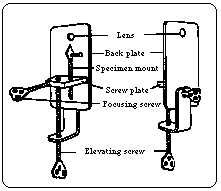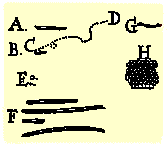

Violet light has the shortest wavelength visible to the human eye, about 450nm. The best light microscopes are capable of magnifying objects up to about 2002 times. To increase the magnification further, it is necessary to use shorter wavelength illumination, e.g. ultraviolet light (wavelength down to 200nm) or electrons (wavelengths down to 0.005nm). In these cases, special imaging systems are needed since the illumination cannot be detected by the eye. However, electron microscopes can achieve magnifications of up to 100,000 times.
 |
Antony van Leeuwenhoek was the first person to see bacteria (1676), using a simple hand-held microscope as shown opposite. These instruments were capable of magnifying between 200 and 300 times, so Leeuwenhoek was just able to see bacteria without making out any details. |
| Leeuwenhoek found many "animicules" between his teeth, such as these he drew in a letter to the Royal Society on 17th September 1683. |  |